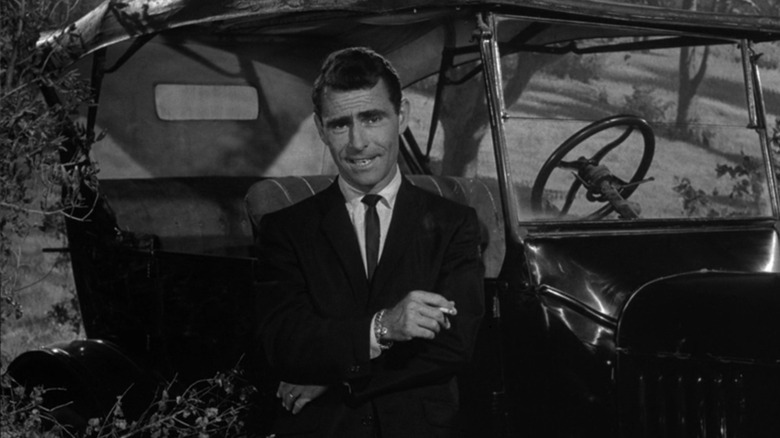The Terrifying Twilight Zone Episode That Inspired Michael B. Jordan's Sinners
Early in 2025, fans were treated to what will surely end up as one of the best films of the year with Ryan Coogler's "Sinners." It's an original horror story set in the deep South in the 1930s, following the Smokestack Twins as they open up a juke joint. Michael B. Jordan turns in not just one but two of his best performances yet as identical twins Smoke and Stack. There are sultry musical numbers, astonishing fight sequences, and even a bunch of Irish vampires singing folk music, making the film a deranged delight.
While "Sinners" itself stands out among the highest-grossing horror movies of all time as an original property, Coogler does count an episode from a classic TV franchise as an inspiration. Speaking with SciFiNow, Coogler revealed, "There's a real deep-cut influence. My favorite thing ever made is 'The Twilight Zone,' and my favorite episode is called 'The Last Rites of Jeff Myrtlebank.'"
"The Last Rites of Jeff Myrtlebank" is a Season 3 episode of the iconic anthology series, centering around the titular Jeff Myrtlebank (James Best), who wakes from death at his own funeral. His small Southern 1920s town is terrified, believing him to be a "haint" — the same word used for the vampires in "Sinners." Despite growing stronger and insisting that he's just fine, everything Jeff touches seems to die. Much like "Sinners," the episode is all about that fine line between life and death.
Plenty of other directors were influenced by The Twilight Zone
Ryan Coogler isn't the only director to draw inspiration from "The Twilight Zone." The 1959 series made an indelible mark on pop culture through its deliciously-twisty stories, trusting not only that audiences would be entertained, but could read into the metaphors and social commentary. As a result, many modern filmmakers look to "The Twilight Zone" as a guidepost for intriguing storytelling.
That includes M. Night Shyamalan, who shouted out the Rod Serling show on X while listing the inspiration for his film "Old." Similarly, Guillermo del Toro is a fan, though claims that Serling's follow-up anthology "Night Gallery" is superior. "In my heart, his stories for 'Night Gallery' are among the most important influences in my creative life and the way I view the world," he wrote in the introduction for the book "Rod Serling's Night Gallery: An After-Hours Tour" (via TheWrap).
It should also come as no surprise that "Get Out" director Jordan Peele is a big fan; after all, Peele hosted a reboot of "The Twilight Zone" in 2019. "Serling's show is important. He is a master of parable. He's a master of allegory," Peele explained to IndieWire. "And what he did was he spoke to society through stories." Such bold storytelling created a ripple effect that lives on in the works of Peele and Ryan Coogler alike.
Ryan Coogler was also inspired by a Disney Channel Original Movie
In the SciFiNow interview where Ryan Coogler revealed other unlikely influences on "Sinners," including the Stephen King novel "'Salem's Lot," the Robert Rodriguez film "The Faculty", and some of the best Coen Brothers movies, like "Fargo" and "Inside Llewyn Davis." Months after the film's release, however, Coogler confessed to an even less obvious source of inspiration for "Sinners" — a 2001 Disney Channel Original Movie called "The Luck of the Irish."
The film is about a teenage basketball player (Ryan Merriman) who finds himself turning into a leprechaun. At a Deadline event, he said that movie introduced him to the Irish music that shows up in "Sinners." He recalled, "That was our first introduction to some of the similarities in Irish folk music to, basically, our music. There was a small Irish community in The Bay, and we would talk about it. That movie was kind of a touchpoint for us to jump off of, crazy enough. We've been fascinated with that culture in my family."
"Sinners" is a great case study of how influence can come from anywhere. Taking inspiration from classic pop culture and merging them with more niche favorites from your childhood, can birth something that feels wholly original.


